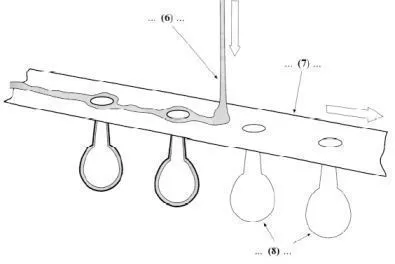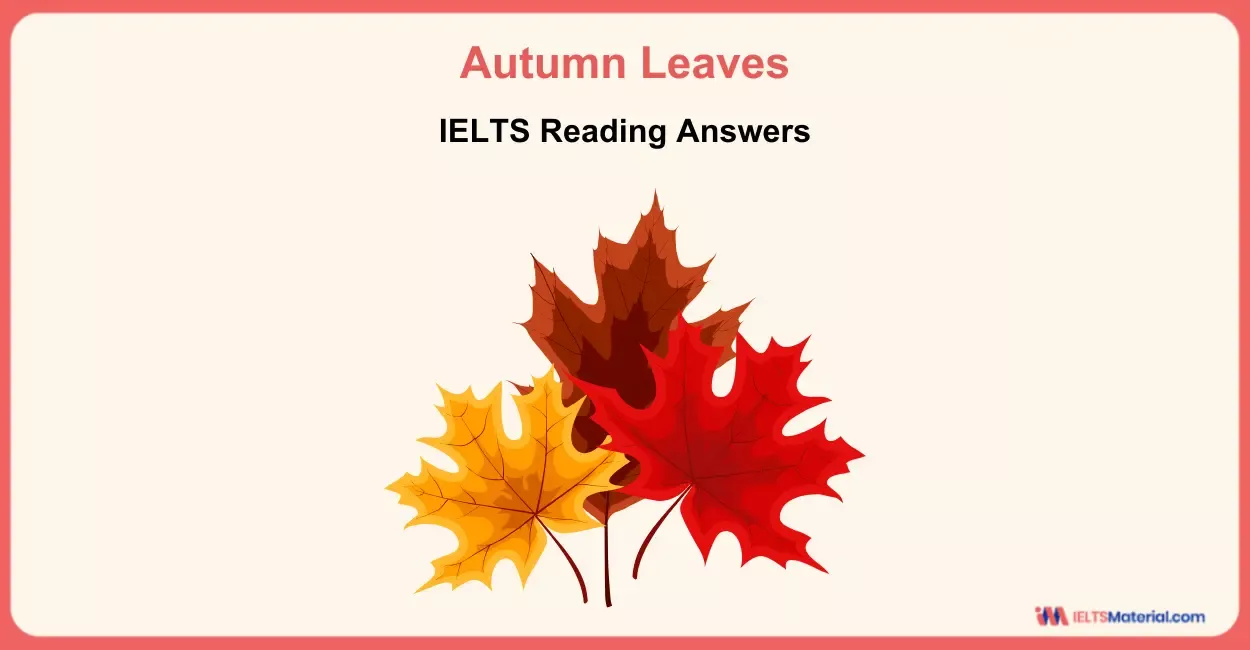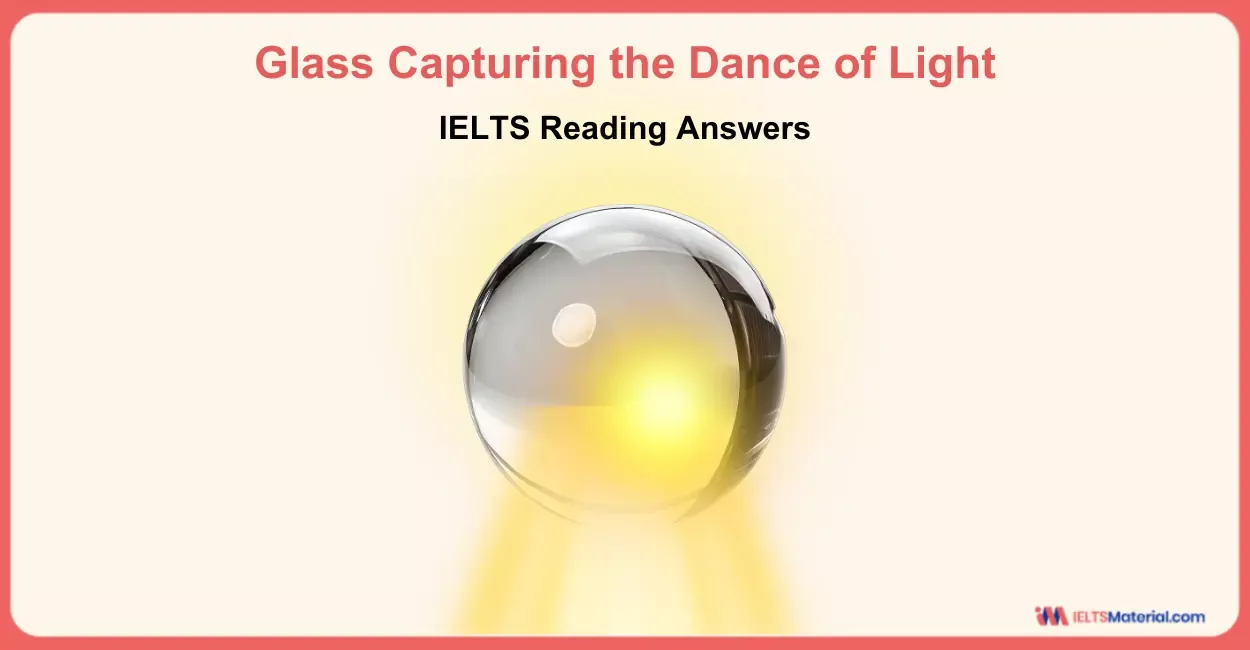Glass Capturing the Dance of Light – IELTS Reading Answers
12 min read
Updated On
-
Copy link
Want to learn how to spot the keywords correctly? Understand paraphrasing, locate information for question types, and tips to prepare with the IELTS Reading passage on ‘Glass Capturing the Dance of Light’ along with answers with explanation.
Table of Contents

Limited-Time Offer : Access a FREE 10-Day IELTS Study Plan!
The IELTS Academic Reading passage, ‘Glass capturing the Dance of Light’, would help you to elevate your preparation level for the Reading section. You must only take 20 minutes for each passage while focusing on mastering the key skills with specific techniques to be accurate and quick at the same time. A careful analysis of your answers while comparing it with the correct ones will help you spot the areas which need improvement. Such consistent practice sessions will assure that your reading strategy remains refined while helping you to score a band 8+ in the IELTS Reading section.
Connect with our band 9 IELTS Trainers to crack your IELTS Reading in no time! Book a FREE Demo.
Types of Questions in IELTS Reading Passage ‘Glass Capturing the Dance of Light’
Remember that it is necessary to know the kinds of questions that will appear before you start answering for the IELTS Reading passage ‘Glass Capturing the Dance of Light’. By looking at the questions first, you would have a clear idea of the structure of the passage, come up with good time management tricks, and read the passage efficiently. Below are the types of questions which you will encounter in this passage.
- IELTS Reading Matching Headings[Q.1-Q.5]
- IELTS Reading Diagram Completion [Q.6-Q.8]
- IELTS Reading Matching Features [Q.9-Q.13]
How to Prepare with the IELTS Reading Passage ‘Glass Capturing the Dance of Light’?
Practicing with different passages which include highly descriptive texts such as ‘Glass Capturing the Dance of Light’ would make preparation much more effective. To excel in the IELTS Exam, you must learn to comprehend scientific terms and also follow through the writers' ideas which are outlined in the paragraphs. Below are certain strategies which will help you to prepare with the passage and use it to your advantage.
- First, you need to understand the main idea in the passage and read using the process of text structuring. This gives you a quick idea of how the passage portrays information.
- Look for technical aspects particularly those dealing with processes or characteristics of glass. This will not only help you to answer questions based on details accurately but this will also improve your knowledge.
- The writers' attitude and tone should be noted which will be helpful in understanding the inference and True/False/Not Given questions.
- When you are done with the passage, go through your answers again so that you can compare it with the correct ones. This will help you to find the mistakes you have been making and focus on improving your strategy.
- Practice with similar topics will boost your confidence as you will get comfortable with difficult words and understand the information faster.
Curious to learn how to attempt Diagram Completion Questions? Check out the video below!
IELTS Reading Passage on ‘Glass capturing the Dance of Light’
You should spend about 20 minutes on Questions 1-13 which are based on the Reading Passage below.
Glass capturing the Dance of Light
A Glass, in one form or another, has long been in noble service to humans As one of the most widely used of manufactured materials, and certainly the most versatile, it can be as imposing as a telescope mirror the width of a tennis court or as small and simple as a marble rolling across dirt The uses of this adaptable material have been broadened dramatically by new technologies glass fibre optics — more than eight million miles — carrying telephone and television signals across nations, glass ceramics serving as the nose cones of missiles and as crowns for teeth; tiny glass beads taking radiation doses inside the body to specific organs, even a new type of glass fashioned of nuclear waste in order to dispose of that unwanted material.
B On the horizon are optical computers These could store programs and process information by means of light - pulses from tiny lasers - rather than electrons And the pulses would travel over glass fibres, not copper wire These machines could function hundreds of times faster than today's electronic computers and hold vastly more information Today fibre optics are used to obtain a clearer image of smaller and smaller objects than ever before -even bacterial viruses. A new generation of optical instruments is emerging that can provide detailed imaging of the inner workings of cells. It is the surge in fibre optic use and in liquid crystal displays that has set the U.S. glass industry (a 16 billion dollar business employing some 150,000 workers) to building new plants to meet demand.
C But it is not only in technology and commerce that glass has widened its horizons. The use of glass as art, a tradition spins back at least to Roman times, is also booming. Nearly everywhere, it seems, men and women are blowing glass and creating works of art. «I didn't sell a piece of glass until 1975,» Dale Chihuly said, smiling, for in the 18 years since the end of the dry spell, he has become one of the most financially successful artists of the 20th century. He now has a new commission - a glass sculpture for the headquarters building of a pizza company -for which his fee is half a million dollars.
D But not all the glass technology that touches our lives is ultra-modern. Consider the simple light bulb; at the turn of the century most light bulbs were hand-blown, and the cost of one was equivalent to half a day's pay for the average worker. In effect, the invention of the ribbon machine by Corning in the 1920s lighted a nation. The price of a bulb plunged. Small wonder that the machine has been called one of the great mechanical achievements of all time. Yet it is very simple: a narrow ribbon of molten glass travels over a moving belt of steel in which there are holes. The glass sags through the holes and into waiting moulds. Puffs of compressed air then shape the glass. In this way, the envelope of a light bulb is made by a single machine at the rate of 66,000 an hour, as compared with 1,200 a day produced by a team of four glassblowers.
E The secret of the versatility of glass lies in its interior structure. Although it is rigid, and thus like a solid, the atoms are arranged in a random disordered fashion, characteristic of a liquid. In the melting process, the atoms in the raw materials are disturbed from their normal position in the molecular structure; before they can find their way back to crystalline arrangements the glass cools. This looseness in molecular structure gives the material what engineers call tremendous "formability" which allows technicians to tailor glass to whatever they need.
F Today, scientists continue to experiment with new glass mixtures and building designers test their imaginations with applications of special types of glass. A London architect, Mike Davies, sees even more dramatic buildings using molecular chemistry. "Glass is the great building material of the future, the «dynamic skim>: he said. "Think of glass that has been treated to react to electric currents going through it, glass that will change from clear to opaque at the push of a button, that gives you instant curtains. Think of how the tall buildings in New York could perform a symphony of colours as the glass in them is made to change colours instantly." Glass as instant curtains is available now, but the cost is exorbitant. As for the glass changing colours instantly, that may come true. Mike Davies's vision may indeed be on the way to fulfilment.
[ Adapted from "Glass: Capturing the Dance of Light" by William S. Ellis, National Geographic. ]
Questions 1 -5
Reading Passage 1 has six paragraphs (A-F).
Choose the most suitable heading/or each paragraph from the list of headings below.
Write the appropriate numbers (i-x) in boxes 1-5 on your answer sheet.
NB There are more headings than paragraphs so you will not use all of them.
You may use any heading more at once.
|
List of Headings
|
1 Paragraph B ……………………………
2 Paragraph C ……………………………
3 Paragraph D ……………………………
4 Paragraph E ……………………………
5 Paragraph F ……………………………
Questions 6-8
The diagram below shows the principle of Coming's ribbon machine.
Label the diagram by selecting NO MORE THAN THREE WORDS from the Reading Passage to fill each numbered space.
Write your answers in boxes 6-8 on your answer sheet.

Questions 9-13
Look at the list below of the uses of glass.
According to the passage, state whether these uses exist today, will exist in the future or are not mentioned by the writer.
In boxes 9-13, write
|
A - if the uses exist today B - if the uses will exist in the future C- if the uses are not mentioned by the writer |
9 dental fittings ……………………………
10 optical computers ……………………………
11 sculptures ……………………………
12 fashions ……………………………
13 curtains ……………………………
Join our IELTS online classes for expert guidance. Sign up today!
Answers with Explanation for ‘Glass Capturing the Dance of Light’
Good job! Did you keep the timer on while attempting the questions? Let’s compare your answers to the answer key and carefully look at the explanations provided. This will make you avoid any repetitive mistakes which you might make and help you to improve your reading accuracy. The table below includes the correct answers for the passage on ‘Glass Capturing the Dance of Light’ along with explanation.
Unlock Answers
| Question Number | Answers | Explanation |
|---|---|---|
| 1. | viii | Paragraph B points out that in present times, ‘fibre optics’ are used to obtain a clearer image of smaller and smaller objects than ever before – even bacterial viruses. A ‘new generation of optical instruments’ (innovated fibre optics) ‘is emerging’ that can ‘provide detailed imaging of the inner workings of cells’ which can lead to exciting discoveries. Hence, the answer is viii (Exciting innovations in fibre optics). |
| 2. | i | Paragraph C mentions that the ‘use of glass as art’, that is, glass crafts, a tradition spins back at least to Roman times, ‘is also booming’ (there is a growth in the demand of glass crafts). Nearly everywhere, it seems, men and women are blowing glass and creating works of art. Hence, the answer is i (Growth in the market for glass crafts). |
| 3. | ix | Paragraph D reveals that not all the glass technology that touches our lives is ultra-modern. For example, the ‘simple light bulb’. At the ‘turn of the century’ (at the end of the previous century, or in former days), most ‘light bulbs were hand blown’, and the cost of one was equivalent to half a day’s pay for the average worker. Hence, the answer is ix (A former glass technology). |
| 4. | iii | Paragraph E discloses that the secret of the ‘versatility’ (adaptability) of glass lies ‘in its interior structure’ (the part/feature that makes glass so adaptable). Although it is rigid, and thus like a solid, the atoms are arranged in a random disordered fashion, characteristic of a liquid. Hence, the answer is iii (What makes glass so adaptable). |
| 5. | vi | Paragraph F divulges that today, scientists continue to ‘experiment with new glass mixtures’ and ‘building designers test their imaginations with applications of special types of glass’ (experiments with glass). A London ‘architect’, Mike Davies, thinks of ‘more dramatic buildings’ made of glass ‘using molecular chemistry’ (more experiments in architecture). Hence, the answer is vi (Architectural experiments with glass). |
| 6. | molten glass//ribbon of glass//molten glass ribbon | Paragraph D illustrates the diagram in the question and is explaining how ‘a narrow ribbon of molten glass’ travels over a moving belt of steel in which there are holes. Hence, the answer is ‘molten glass//ribbon of glass//molten glass ribbon’. |
| 7. | belt of steel/steel belt/moving belt | Paragraph D explains how a narrow ribbon of molten glass travels over a ‘moving belt of steel’ in which there are holes that can be seen in the diagram in the question. Hence, the answer is ‘belt of steel/steel belt/moving belt’. |
| 8. | (lightbulb) moulds | Paragraph D gives the details of how the glass sags through the holes and into ‘waiting moulds’ as we can see in the diagram. Puffs of compressed air then shape the glass. In this way, the envelope of a light bulb is made. Hence, the answer is ‘(lightbulb) moulds’. |
| 9. | A | Paragraph A lists the uses of glass that have been broadened dramatically by new technologies glass fibre optics — more than eight million miles — carrying telephone and television signals across nations, glass ceramics serving as the nose cones of missiles and as ‘crowns for teeth’, which refers to dental fittings. As it is still used, the answer is A (if the uses exist today). |
| 10. | B | Paragraph B begins with the statement that ‘optical computers’ are ‘on the horizon’, that is they are the advanced step of today’s electronic computers. They could store programs and process information by means of light – pulses from tiny lasers – rather than electrons. ‘These machines could function hundreds of times faster than today’s electronic computers’ and hold vastly more information. Therefore, with the development of fibre optics, present day computers will also advance into optical computers which will continue to be used in the near future. Hence, the answer is B (if the uses will exist in the future). |
| 11. | A | Paragraph C states that Dale Chihuly ‘now’ (at present time/today) has a new commission – a ‘glass sculpture’ for the headquarters building of a pizza company – for which his fee is half a million dollars. Hence, the answer is A (if the uses exist today). |
| 12. | C | In the passage, the author has described how the uses of glass have changed over time. Various uses and advancements in items like bulbs, computers, fiber optics, glass crafts are mentioned. But there is no mention of how glass has been or will be used in fashions. Hence, the answer is C (if the uses are not mentioned by the writer). |
| 13. | A | Paragraph F describes how glass that has been treated to react to electric currents going through it, glass that will change from clear to opaque at the push of a button, that gives you instant curtains. ‘Glass as instant curtains is available now’, but the cost is exorbitant.
Hence, the answer is A (if the uses exist today). |
Join our IELTS webinars to learn master tips for the Reading section! Click here to explore!
Practicing with IELTS Reading passages such as ‘Glass Capturing the Dance of Light’ would help you with the reviewing of answers, paraphrasing of information, and explanation of answers. This will improve your comprehension skills while avoiding the common mistakes in the exam. Along with that, you will also get accustomed to different types of questions along with the specific strategies while improving your confidence to perform well during the actual exam.
Check More IELTS Reading Answers
Also check :
Practice IELTS Reading based on question types

Start Preparing for IELTS: Get Your 10-Day Study Plan Today!
Explore other Reading Practice Tests

Kasturika Samanta

Kasturika Samanta

Nehasri Ravishenbagam
Recent Articles

Nehasri Ravishenbagam

Haniya Yashfeen

Haniya Yashfeen

Haniya Yashfeen





Post your Comments